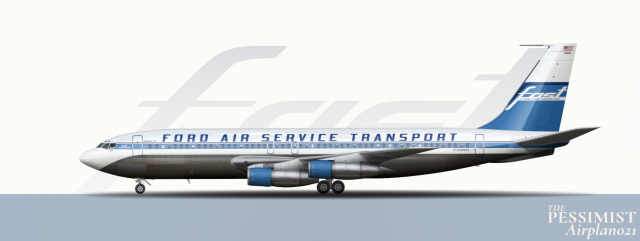
1964 Boeing 707
- Owner: ThePessimist (View all images and albums)
- Uploaded: Jan 01 2023 11:00 PM
- Views: 1,222
- Album Valiant Airways

Valiant Holding Group, despite making strides in various miscellaneous endeavours including construction and air transportation, remained most notable and valuable for its water transportation division. Even as industry began its exodus from Detroit and America’s industrial heartland on the coasts of the Great Lakes, demand for the bulk transportation of raw and processed materials continued to rise. Valiant, with its significant share of this transportation market, became a target for “investment”. The Kennedy administration appeared poised to relax previously strict, structuralist interpretations of antitrust law. With this in mind, the Ford Motor Company considered a strategy to lower costs that would differ from its competitors. Whilst GM, Chrysler, and the ailing AMC invested in pushing production abroad – Ford investigated returning to an older cost saving strategy: vertical integration. Haggling with companies that specialised in the production and transportation of steel and other materials critical to the production of automobiles significantly raised costs. If Ford owned these corporations then there would be no possibility for costs to be unduly raised. Ford’s first target was chosen because it was a large – but not huge pickup. Valiant was not the largest shipper on the Great Lakes, but its operations could be reorganised to satisfy Ford’s production needs. However, because it was not a dominant force in any market, Ford correctly surmised that regulators would not be too recalcitrant when considering a takeover bid. In 1962, Ford approached VHG with a full takeover offer that was too good to turn down.
Even though Ford’s purchase of VHG was made to secure the company’s shipping fleet, it left them in control of many vestigial enterprises. Some Ford executives pushed to sell off these enterprises, including the Valiant Air Division, but Ford was no stranger to unusual business investments and all of VHG’s divisions survived the acquisition. Ford allowed Valiant’s water transportation assets to continue under the historic name, but everything else needed new identities to fit into the burgeoning Ford Family Corporations (FFC) brand. This was not an easy process given the number and diversity of the various operations which needed new identities (particularly so when considering that Ford planned to continue to acquire other companies in the coming years to further the verticality of its integration). Ford was not interested in putting big bucks towards the program though and some of the resultant brands were less than stellar, not that it mattered much given that they were not consumer facing and so their name and identity were little more than a formality.
However, the airline Ford now owned needed a name and unlike many other new FFC brands, this one did face the public. VAD became Ford Air Service Transport, stylized as FAST, and unveiled its new identity and new livery in early 1964. During the acquisition, the operation had managed to avoid much instability. Executives left it alone even as they radically reorganised the water transportation division. The airline’s new livery was not ground-breaking, but it represented the professional and stalwart appearance that FFC meant to exude. This appearance was not actually a complete failure with consumers. Particularly, in the early and mid 60s, FAST established itself amongst the professional community as a provider of extremely reliable service.
With Ford’s backing, FAST inaugurated an aggressive program of fleet modernization and expansion in the mid 60s. The carrier stepped up its commitment to Boeing when it ordered the 727 and 737 over Douglass’ DC-9 when it chose to exterminate propellered aircraft from its mainline fleet. Ford also financed the purchase of Marshall Airlines which opened up the Jacksonville hub and operations throughout the South in 1967. Ford’s management hired the best and the brightest executives it could find to manage an airline and the new management team was extremely proficient. The 60s and early 70s were a time of growth and development of the carrier’s market, enough so that Ford executives who had pushed for cutting off Air Service Transport operations largely stopped. However, the success of the VHG acquisition had not gone completely unnoticed by Federal antitrust regulators. Further, the success of ancillary business ventures within the increasingly diversified Ford Family of Corporations intensified scrutiny. Thus, the plan to vertically integrate Ford’s production chain started and ended with VHG. Executives feared that procuring other critical assets, particularly certain mining operations, would bring down the hammer of the Sherman Act. Their inaction saved the company from any actual regulatory activity, at least for a time. Thus, VHG became part of Ford, VAD became FAST, and Ford learned that owning an airline was not the economic hinderance some had feared.

 Sign In
Sign In Create Account
Create Account











excellent job